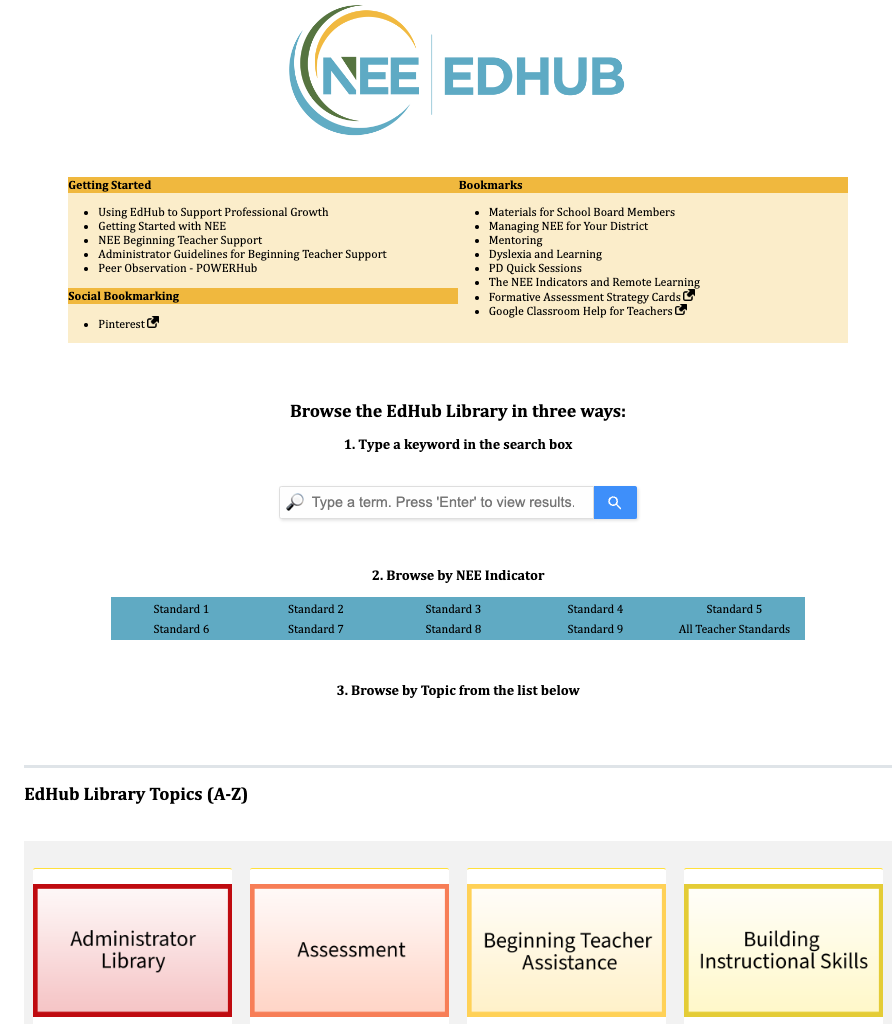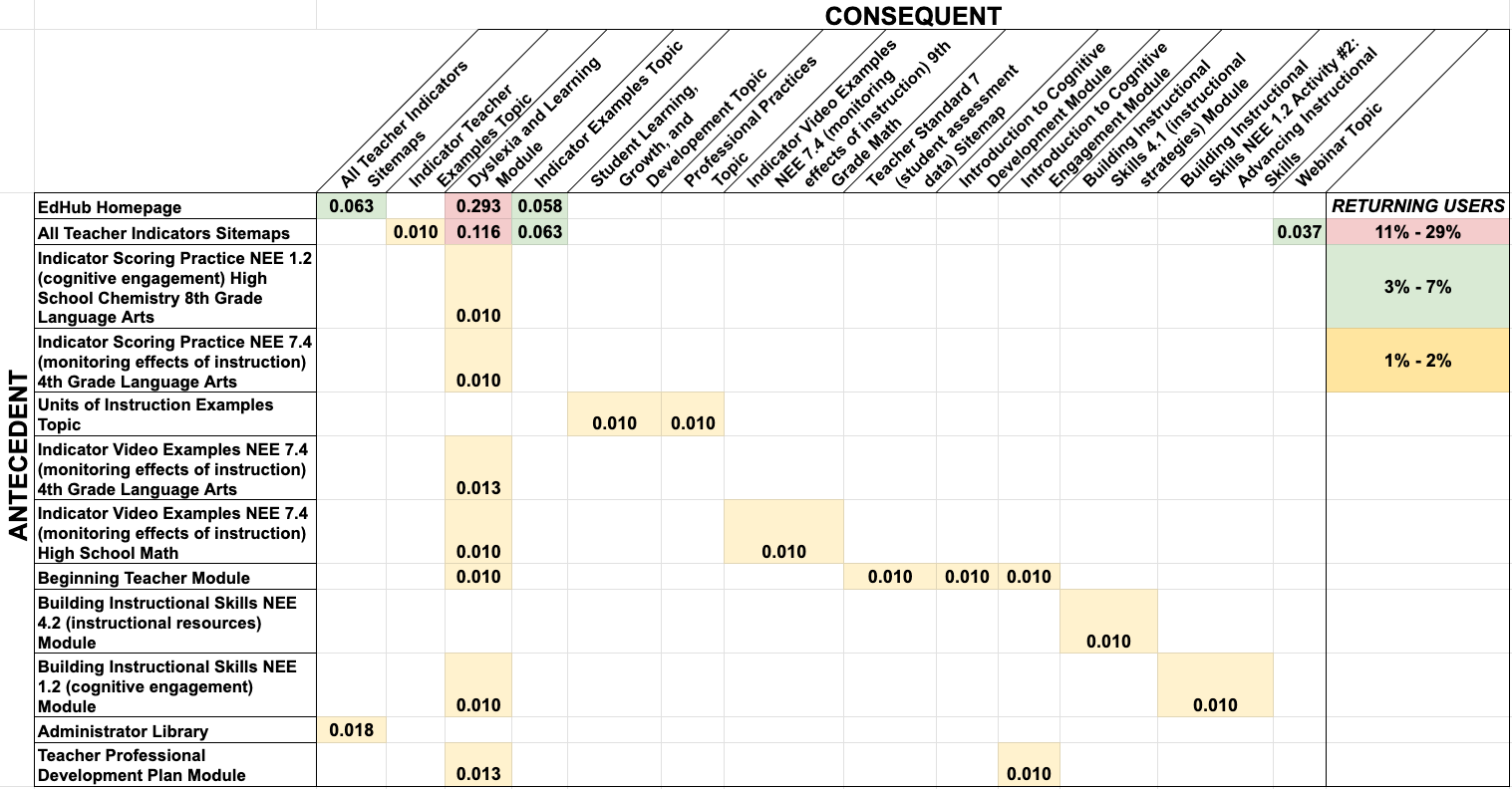As part of the Network for Educator Effectiveness (NEE), the EdHub Library has provided K-12 educators with over 500 self-paced activities on research-based teaching practices and classroom simulations since 2014. Educators can access all library topics via the homepage, search engine, or teacher indicator sitemaps, as shown in Figure 1. The library uses a three-level information architecture with each module containing 3-5 independent activities.
Figure 1
EdHub Library Homepage

Educators display agency, self-regulation, and self-efficacy when seeking knowledge from online repositories (Liu et al., 2023). Educators with high self-efficacy can effectively achieve learning goals using cognitive and metacognitive strategies (Cheng, 2011; Panadero, 2017; Yoo, 2016; Zimmermann, 1989). Meanwhile, studies have explored the potential of association rule mining (ARM) for content curation and personalization of online resources in large-scale professional development libraries (Chen & Su, 2019; Tondeur et al., 2021). ARM can also identify online resources suitable for rural schools with limited internet speeds (Leung, 2021; Standl & Schlomske-Bodenstein, 2021).
The teacher professional development (PD) literature lacks exploration of data-driven approaches to curating resources across various content types and teacher standards, which can support educators’ professional growth and student outcomes, making it challenging to offer specific recommendations within extensive libraries like EdHub due to educators' diverse PD needs.
This study aims to extract association patterns from web analytics data from the 2022-2023 school year using ARM to curate related resources within the library as part of continuous improvement efforts. This study explores the following research questions. RQ1: What are the characteristics of association patterns among resources for new and returning users? This question is crucial for understanding how educators interact with the library and how their behavior can be used to improve the user experience. RQ2: Which professional development modules are accessed frequently together for new and returning users? This question is essential for identifying the most frequently accessed modules, which can guide content curation efforts within EdHub.
Web analytics data was collected using a Python script in Jupyter Notebooks with access to the Google administrator dashboard. FP-Growth (Frequent Pattern Growth) was used to analyze Time On Page and User Type for association patterns among resources. Time On Page measures how long a user spends browsing a page, while User Type assigns whether users are new or returning (Leung, 2018, 2021, 2022).
FP-Growth uses a tree-based data structure to find frequent association patterns in large datasets. It then recursively explores this tree to generate association patterns based on support and confidence thresholds. It is more efficient than the Apriori algorithm in identifying frequent association patterns (Raschka, n.d.).
The study used support and confidence measures to evaluate association patterns for new and returning users. Support measures how frequently an association pattern appears in the dataset, while confidence measures the likelihood of one resource appearing given the presence of another resource. The FP-Growth support parameter was set to 0.01 (1%) for support and 1 (100%) for confidence to generate association patterns with the highest confidence measure for all resources. Association patterns for new and returning users were visualized in two matrices, with antecedents on the left-hand side and consequents on the right-hand side that provide insights into how users supplement their knowledge across topics (Yang, 2009). Visual representation of association patterns is crucial for conveying actionable steps to stakeholders. Association patterns do not represent causation but relationships among different topics and modules for making data-driven PD recommendations.
ARM with FP-Growth generated 103,011 and 27,933 association patterns for new and returning users, respectively. The highest support measures were 33.5% for new users and 29.3% for returning users, with 100% confidence measures for both types. For new users, 33.5% of web traffic involved accessing Dyslexia and Learning activities, following the suggested instructional sequence. These support measures are shown in red in Figure 2. For returning users, 29.3% of traffic involved accessing the Dyslexia and Learning module from the EdHub homepage bookmark and teacher indicator sitemaps, shown in red in Figure 3. No association patterns were found in webinar-related topics for new users except for about 3% of returning users who accessed webinars from the teacher indicator sitemaps, shown in green in Figure 3. No association patterns were found in search engine queries for both user types, indicating a preference for browsing materials via the homepage and teacher indicator sitemaps.
Regarding new users, the association patterns showed support measures between 15% and 34%, shown in red in Figure 2, indicating that educators generally followed the instructional sequence of the four activities in the Dyslexia and Learning module. Support measures decreased from 33.5% for the initial activity to 15% for the last activity, suggesting that not all educators followed the sequence and preferred certain activities.
The second-highest association patterns had support measures between 3% and 8%, shown in green in Figure 2, for modules in Building Instructional Skills in NEE 1.2 (cognitive engagement), Examples of Classroom Observation, and Examples of Units of Instruction. 5.7% of web traffic indicated new users accessed the introductory EdHub lesson before the Dyslexia and Learning module, and 3% showed educators accessed principal-related materials followed by teacher indicator sitemaps, suggesting that administrators used these sitemaps to narrow PD materials.
The lowest association patterns for new users had support measures between 1% and 2%, shown in yellow in Figure 2, for Examples of Classroom Observation for NEE 1.1 (content knowledge and academic language), 1.2 (cognitive engagement), 4.1 (problem-solving), and 7.4 (collaborative data analysis), followed by the Dyslexia and Learning module. New users, who initially accessed the Beginning Teacher Assistance module, subsequently accessed the Building Instructional Skills in NEE 1.2 (cognitive engagement), Examples of Classroom Observation, and Classroom Motivation Strategies.
Figure 2
Association Patterns for New Users with Support Measures

Regarding returning users, support measures ranged between 11% and 29%, shown in red in Figure 3. This shows that educators accessed the Dyslexia and Learning module from the EdHub homepage bookmark more than the teacher indicator sitemaps. No association patterns existed between the Student Learning, Growth, and Development topic category and the Dyslexia and Learning module, indicating a preference for accessing Dyslexia-related materials from the homepage and teacher indicator sitemaps. 11.6% of web traffic showed returning educators accessing the Dyslexia and Learning module from teacher indicator sitemaps, shown in red in Figure 3.
The second-highest association patterns for returning users had support measures between 3% and 7%, shown in green in Figure 3. Educators used teacher indicator sitemaps and the EdHub homepage to locate specific PD across multiple teacher standards and access PD from the Examples of Classroom Observation and Webinar topic categories.
The lowest association patterns had support measures between 1% and 2%, shown in yellow in Figure 3, in three library topic areas as the antecedents: Indicator Scoring Practice Videos for NEE 1.2 (cognitive engagement) and 7.4 (collaborative data analysis), Building Instructional Skills for NEE 4.2 (enhancing student learning with instructional resources), and Examples of Units of Instruction. These led to different resources, as the consequents, in the Dyslexia and Learning module, Examples of Classroom Observation for NEE 7.4 (collaborative data analysis), Building Instructional Skills for NEE 4.1 (problem-solving), and several modules in Student Learning, Growth, and Development topic. Association patterns of around 1% showed beginning teachers supplementing their knowledge between the Beginning Teacher Assistance module and modules not currently recommended, including the teacher sitemap for NEE Standard 7 (student assessment data), Introduction to Cognitive Development and Engagement, and Building Instructional Skills for NEE 4.1 (problem-solving).
Figure 3
Association Patterns for Returning Users with Support Measures

Association patterns were observed in five topics: Beginning Teacher Assistance, Examples of Classroom Observation, Dyslexia and Learning, Scoring Classroom Observation Practice Simulations, and Professional Development Plans for Teachers. Association patterns indicated how school administrators used teacher indicator sitemaps and how teachers leveraged the bookmark section to review specific PD content.
The findings are relevant to managing the online PD platform as results provide insights into how educators, particularly new teachers, expand their knowledge across different topics. The Beginning Teacher Support module introduces new teachers to PD search in EdHub and four essential functions to support student learning through classroom culture, learning environment, instructional practices, and student engagement. Despite the lowest association patterns for new and returning users in Beginning Teacher Assistance, PD recommendations for this module can be drawn from other topics in Student Assessment, Cognitive Development, Cognitive Engagement, Examples of Units of Instruction, and Building Instructional Skills related to NEE 1.2 (cognitive engagement) and 4.1 (problem-solving).
Even though ARM can aid in continuous improvement efforts and offers valuable insights, the findings may only apply to specific contexts.
This study examined the related or associated instructional resources frequently accessed and generated insights into how educators accessed different topics and modules together and leveraged certain library features to locate specific PD. The benefits of ARM include implementing the personalization and curation of learning pathways, improving user experience, and increasing resource accessibility. ARM can also be incorporated into the instructional design model's analysis and evaluation phases as a data-driven approach.